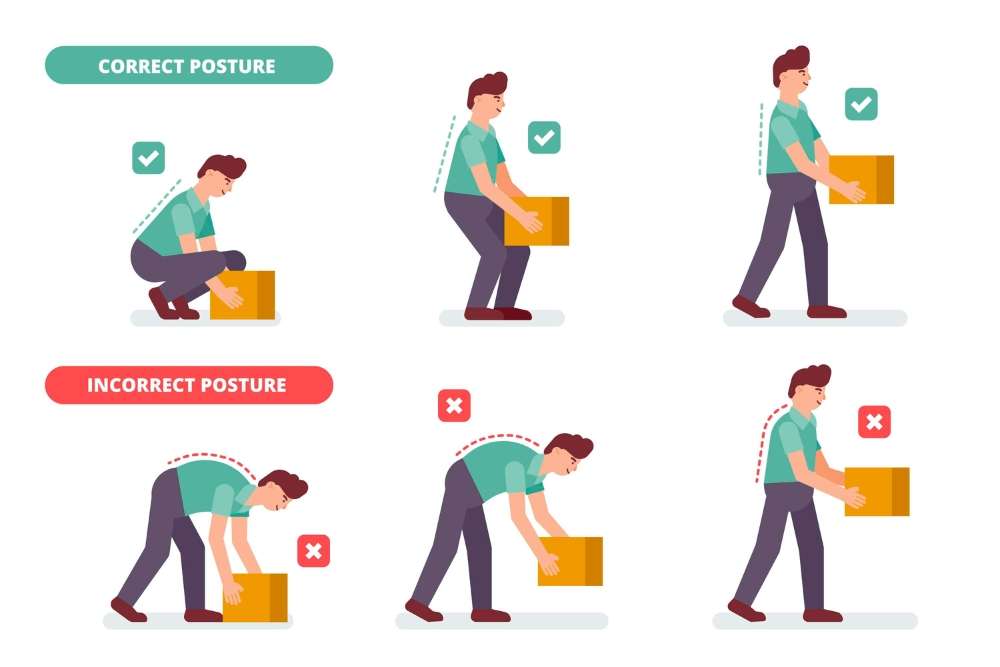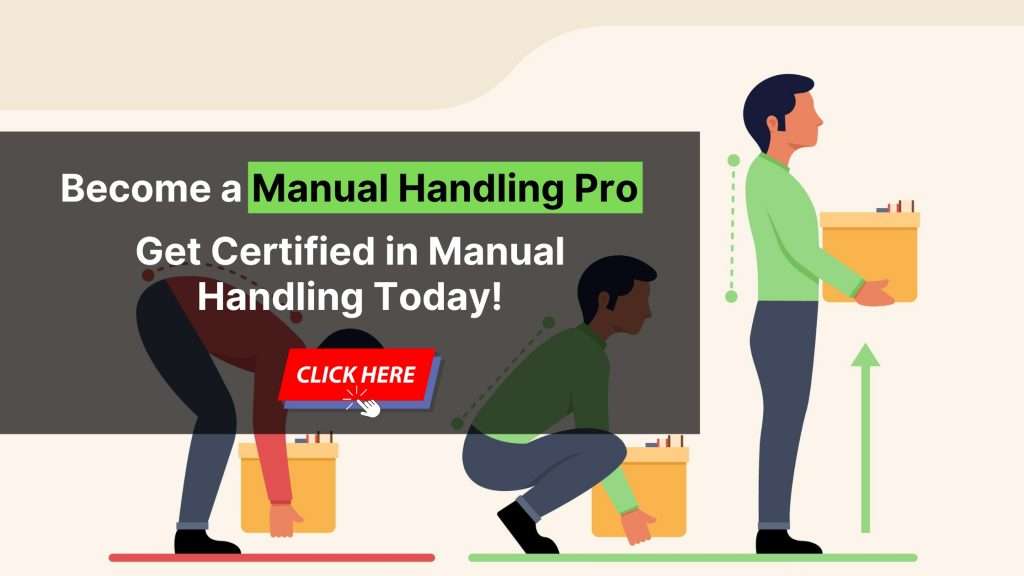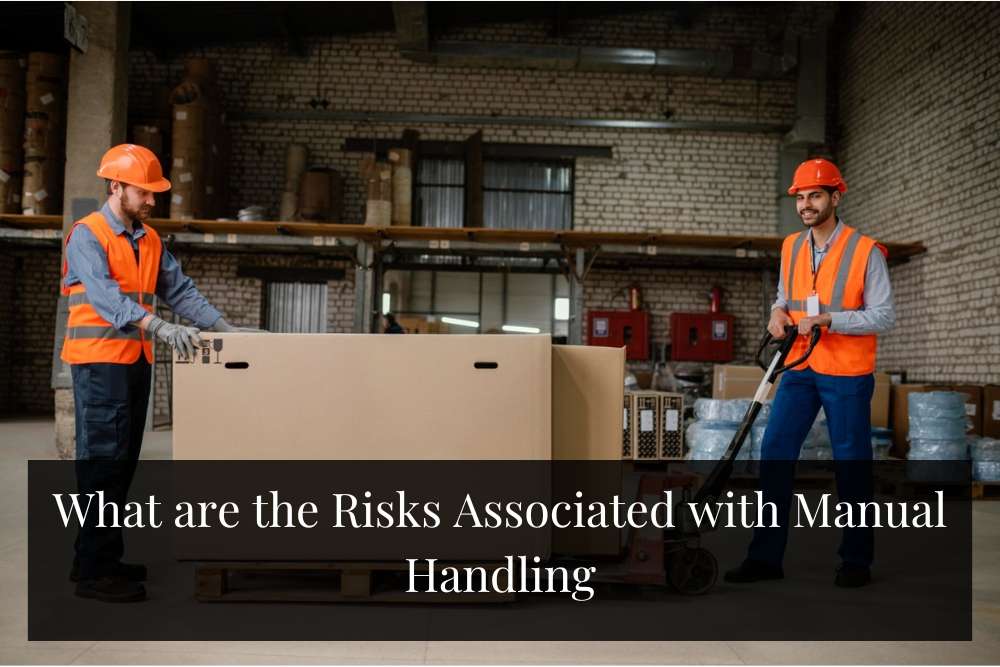Manual handling, in its essence, refers to the physical tasks that involve the lifting, carrying, pushing, pulling, or moving of objects or loads. It encompasses any action that requires the use of force or effort exerted by an individual. This can include a wide range of activities, from simply picking up a box to maneuvering heavy machinery. Manual handling is an integral part of many work environments and daily activities, but it is crucial to recognize the potential risks associated with these tasks.
By acknowledging the risks, individuals can implement necessary precautions and adopt appropriate techniques to minimize the likelihood of accidents and injuries. It allows them to identify potential hazards, assess the weight, size, and stability of objects being handled, and determine the most efficient and safe methods for completing the tasks at hand.
I.Physical Risks
A.Musculoskeletal disorders
- Definition and examples: Musculoskeletal disorders (MSDs) encompass a range of conditions that affect the muscles, tendons, ligaments, joints, and other structures that support the body’s movement. These disorders can manifest as pain, stiffness, swelling, and limited mobility. Examples of MSDs include tendinitis, carpal tunnel syndrome, herniated discs, and rotator cuff injuries.
- Common areas affected: MSDs can impact various areas of the body, with some of the most commonly affected regions including the back, neck, shoulders, wrists, and knees. These areas are particularly susceptible to injury due to their involvement in repetitive or forceful movements, awkward postures, or sustained exertion during manual handling tasks.
- Causes and contributing factors: Several factors contribute to the development of MSDs in relation to manual handling. These factors can include lifting heavy loads, repetitive motions, prolonged awkward postures, insufficient rest breaks, inadequate training, and poor ergonomics. Additionally, environmental factors such as temperature, vibration, and inadequate lighting can further exacerbate the risk of developing MSDs.
B.Acute injuries
- Strains and sprains: Strains and sprains are common acute injuries associated with manual handling. Strains refer to the stretching or tearing of muscles or tendons, while sprains involve the stretching or tearing of ligaments. These injuries can occur when excessive force is exerted on a muscle or joint during lifting, carrying, or sudden movements. Improper lifting techniques, overexertion, and fatigue can increase the likelihood of strains and sprains.
- Fractures and dislocations: Fractures and dislocations are more severe acute injuries that can result from manual handling accidents. Fractures occur when bones break, while dislocations involve the displacement of bones from their normal positions. These injuries can occur due to falls, heavy objects falling on a body part, or sudden impacts during manual handling tasks. Poor grip, inadequate protective equipment, and working in unstable or cluttered environments can contribute to the risk of fractures and dislocations.
- Causes and prevention strategies: Acute injuries during manual handling tasks can be caused by various factors. Poor lifting techniques, such as bending from the waist or lifting with the back instead of the legs, increase the risk of strains, sprains, fractures, and dislocations. Additionally, rushing, inadequate warm-up exercises, and lack of proper planning can further contribute to the occurrence of acute injuries.
Prevention strategies for acute injuries include providing comprehensive training on proper lifting and carrying techniques, emphasizing the use of mechanical aids or equipment when handling heavy loads, and promoting the importance of physical fitness and warm-up exercises. Employers should ensure a safe work environment by maintaining clear walkways, removing obstacles, and implementing effective hazard identification and control measures. Regular breaks and rotation of tasks can also help alleviate the risk of acute injuries.
II.Ergonomic Risks
A.Repetitive strain injuries
- Definition and examples: Repetitive strain injuries (RSIs) refer to a group of conditions that result from repetitive or prolonged movements, often combined with forceful exertion. These injuries typically develop gradually over time and affect the soft tissues, including muscles, tendons, nerves, and ligaments. Examples of RSIs include carpal tunnel syndrome, tennis elbow, and rotator cuff tendonitis.
- Commonly affected body parts: RSIs can affect various body parts, depending on the nature of the repetitive tasks performed. Commonly affected areas include the hands, wrists, elbows, shoulders, neck, and lower back. These body parts are particularly vulnerable when subjected to repetitive motions, excessive force, or sustained awkward postures.
- Risk factors and prevention measures: Several factors contribute to the development of RSIs during manual handling tasks. Risk factors can include repetitive motions, high force requirements, inadequate rest periods, improper workstation setup, and poor tool or equipment design. It is crucial to implement preventive measures to mitigate these risks.
Prevention strategies for RSIs involve optimizing work processes to reduce repetitive movements and forceful exertion. This can be achieved through task rotation, job enrichment, and the use of ergonomic tools and equipment. Providing proper training on posture, stretching exercises, and maintaining a neutral body alignment during tasks can also help prevent RSIs. Employers should conduct ergonomic assessments, make necessary adjustments to workstations, and encourage employees to take regular breaks to rest and recover.
B.Awkward postures and positions
- Impact on the musculoskeletal system: Awkward postures and positions during manual handling tasks can exert excessive strain on the musculoskeletal system, leading to discomfort, pain, and increased risk of injury. Adopting awkward postures, such as bending, twisting, or reaching, places stress on the spine, joints, and muscles, disrupting their natural alignment and causing musculoskeletal imbalances.
- Risk factors and prevention strategies: Various risk factors contribute to the occurrence of awkward postures during manual handling tasks. These include limited workspace, improperly designed workstations or equipment, heavy loads, inadequate training, and time pressure. It is essential to address these risk factors through appropriate preventive measures.
Prevention strategies for awkward postures involve optimizing workstations and workflows to minimize the need for excessive bending, twisting, or reaching. This can be achieved through proper arrangement of tools, equipment, and materials within easy reach. Ergonomic modifications, such as adjustable work surfaces, supportive seating, and lift-assist devices, can also facilitate neutral and comfortable body positions during manual handling tasks. Training programs should emphasize the importance of maintaining proper posture and body mechanics, as well as the use of assistive devices when necessary.
By implementing these preventive measures, the risks associated with repetitive strain injuries and awkward postures can be effectively mitigated. This not only protects the musculoskeletal health of individuals engaged in manual handling but also promotes overall well-being, productivity, and job satisfaction.
III.Environmental Risks
A.Hazards in the workplace
- Poor lighting and visibility: Inadequate lighting in the workplace can pose significant risks during manual handling tasks. Insufficient illumination can impair depth perception, making it challenging to accurately gauge distances and properly assess the weight, size, and stability of objects being handled. This increases the likelihood of accidents, such as collisions with objects or tripping over obstacles. Proper lighting is essential to ensure clear visibility, promote safety, and enable individuals to perform manual handling tasks with accuracy and confidence.
- Uneven or slippery surfaces: Uneven or slippery surfaces in the workplace present a considerable hazard during manual handling activities. Such surfaces can lead to slips, trips, and falls, which can result in severe injuries. Uneven flooring, loose mats, spills, or wet surfaces increase the risk of accidents, as individuals may lose their footing, struggle to maintain balance or experience sudden shifts in body weight while handling objects. Regular maintenance, effective housekeeping practices, and the use of appropriate flooring materials and anti-slip measures are crucial to reduce the risk of accidents related to uneven or slippery surfaces.
- Cluttered work areas: Cluttered work areas can impede safe manual handling practices. Objects strewn about or improperly stored can obstruct pathways, limit maneuverability, and increase the chances of collision or entanglement. Clutter also makes it difficult to identify potential hazards or locate necessary equipment, potentially leading to delays and errors during manual handling tasks. Organizational strategies, such as implementing clear storage systems, maintaining tidy workspaces, and promoting a culture of cleanliness and orderliness, are vital to minimize the risks associated with cluttered work areas.
B.Psychosocial factors
- Stress and job dissatisfaction: Psychosocial factors, such as stress and job dissatisfaction, can have a significant impact on manual handling practices. High levels of stress, whether due to excessive workload, time pressure, or interpersonal conflicts, can impair concentration, decision-making abilities, and overall job performance. In the context of manual handling, stress can increase the risk of errors, inadequate attention to safety protocols, and compromised judgment, potentially leading to accidents or injuries. Job dissatisfaction can also contribute to a lack of motivation and engagement, potentially resulting in carelessness or reduced adherence to safe handling practices.
- Impact on manual handling practices: Psychosocial factors can affect manual handling practices in various ways. Individuals experiencing high levels of stress or job dissatisfaction may be more prone to rushing, taking shortcuts, or neglecting safety procedures during manual handling tasks. Additionally, these factors can contribute to reduced communication and cooperation among team members, impairing the overall coordination and effectiveness of manual handling operations. It is crucial to address psychosocial factors by implementing supportive work environments, promoting work-life balance, fostering open communication, and providing resources for stress management and job satisfaction enhancement. By addressing these factors, organizations can foster a positive work culture that promotes safe manual handling practices and prioritizes the well-being of their employees.
IV.Legal and Financial Risks
A.Compliance with regulations and standards
Compliance with regulations and standards is essential to mitigate legal and financial risks associated with manual handling. Governments and regulatory bodies enforce specific guidelines and requirements to ensure the safety and well-being of workers. Non-compliance with these regulations can result in penalties, fines, and legal liabilities for employers. It is crucial for organizations to stay up-to-date with relevant regulations, implement necessary safety measures, and provide appropriate training to ensure compliance with standards. By adhering to these regulations, employers can protect their workforce, maintain a positive reputation, and avoid legal repercussions.
Read further about Compliance with Manual Handling Laws here.
B.Workers’ compensation and liability issues
Manual handling injuries can lead to workers’ compensation claims and liability issues for employers. Workers’ compensation is a system designed to provide financial assistance to employees who suffer work-related injuries or illnesses. When an employee is injured during manual handling tasks, they may be entitled to compensation for medical expenses, lost wages, and rehabilitation costs. Failure to provide adequate training, safe work environments, or necessary equipment can result in higher workers’ compensation costs for employers. Additionally, negligence or non-compliance with safety regulations may expose employers to liability claims and potential lawsuits. Employers should prioritize the well-being of their employees, take proactive steps to prevent injuries, and ensure they have appropriate insurance coverage to address workers’ compensation claims and potential liability issues.
C.Cost of injuries and associated expenses
Manual handling injuries can impose significant financial burdens on individuals and organizations. The costs associated with injuries include medical expenses, rehabilitation costs, lost productivity, and potential legal fees. Injuries may result in extended periods of absence from work, impacting productivity and leading to additional costs for temporary staffing or overtime payments. Moreover, organizations may face indirect costs such as decreased employee morale, higher turnover rates, and potential damage to their reputation. By investing in proper training, ergonomic equipment, and safety measures, organizations can reduce the occurrence of manual handling injuries and minimize the associated financial burdens.
Efficient risk management strategies, including robust safety programs, comprehensive training, and regular inspections, are crucial for mitigating legal and financial risks related to manual handling. By prioritizing compliance with regulations, providing workers’ compensation coverage, and implementing preventive measures, organizations can safeguard the well-being of their employees and protect themselves from potential legal and financial consequences.
V.Strategies for Risk Reduction
A.Training and education

- Proper lifting techniques: Training programs should focus on teaching employees proper lifting techniques to reduce the risk of injuries during manual handling tasks. This includes instructing individuals on how to lift with their legs, maintain a straight back, and avoid twisting or jerking motions. By educating employees on proper lifting techniques, organizations can empower them with the knowledge and skills necessary to perform manual handling tasks safely.
- Ergonomic principles and body mechanics: Education on ergonomic principles and body mechanics is crucial to minimize the risk of musculoskeletal disorders. Employees should be trained to understand the importance of maintaining neutral postures, utilizing ergonomic equipment and tools, and adopting proper body mechanics while performing manual handling tasks. This knowledge enables individuals to optimize their movements, reduce strain on the musculoskeletal system, and minimize the risk of injuries.
Looking for an Online Manual Handling Certification Training? You may Enroll here.
B.Engineering controls and workplace design
- Mechanical aids and equipment: Implementing mechanical aids and equipment can significantly reduce the physical demands of manual handling tasks. This may include the use of lifting devices, conveyors, or adjustable height workstations. By providing employees with access to appropriate mechanical aids, organizations can minimize the need for heavy manual lifting, decrease the risk of strain and injury, and enhance overall efficiency.
- Workstation ergonomics: Creating ergonomically designed workstations promotes safe and comfortable manual handling practices. Workstation ergonomics involve adjusting the layout, height, and arrangement of tools, equipment, and work surfaces to suit the physical requirements and capabilities of employees. This helps to minimize awkward postures, reduce excessive reaching or bending, and ensure proper body alignment during manual handling tasks.
C.Risk assessment and management
- Identifying hazards and potential risks: Conducting thorough risk assessments is essential to identify potential hazards and risks associated with manual handling tasks. This involves analyzing work processes, observing task performance, and consulting employees to identify potential sources of injuries or ergonomic issues. By proactively identifying hazards, organizations can implement targeted preventive measures and reduce the likelihood of accidents or injuries.
- Implementing preventive measures: Based on the findings of risk assessments, organizations should implement appropriate preventive measures. This may include modifying work processes, providing necessary training and equipment, implementing engineering controls, and establishing safe work procedures. Regular evaluations and feedback from employees can help ensure the effectiveness of these preventive measures and allow for continuous improvement.
D.Promoting a safety culture
- Employee involvement and engagement: Promoting a safety culture involves actively involving employees in safety initiatives and decision-making processes. Organizations should encourage open communication channels, where employees can voice their concerns, provide feedback, and participate in safety committees or programs. By involving employees in safety-related discussions and decision-making, organizations can tap into their expertise, increase engagement, and foster a shared responsibility for maintaining a safe work environment.
- Reporting and addressing concerns: Establishing a reporting system for safety concerns is crucial to promptly address potential risks. Employees should be encouraged to report any hazards, incidents, or near-miss events related to manual handling tasks. Organizations should prioritize addressing these concerns in a timely manner, investigating root causes, and implementing corrective actions to prevent future occurrences. This proactive approach creates a sense of trust and confidence among employees, further reinforcing the safety culture within the organization.

Conclusion
Understanding and actively managing the risks associated with manual handling is of paramount importance. Proactive risk management helps prevent injuries, reduce financial liabilities, and maintain a safe work environment. By implementing strategies such as training and education, engineering controls, risk assessment and management, and promoting a safety culture, organizations can significantly mitigate risks and protect the well-being of their employees. Proactive risk management also ensures compliance with regulations, minimizes legal and financial repercussions, and fosters a positive work culture.
Frequently Asked Questions (FAQs)
What are the 5 manual handling activities?
The five types of manual handling activities involve lifting, lowering, pushing, pulling, and carrying objects or loads by hand.
What is correct manual handling?
Correct manual handling refers to using safe techniques and principles to move objects or loads without causing harm or injury to oneself or others. It involves employing proper lifting techniques, utilizing mechanical aids when necessary, and maintaining good posture and body mechanics.
Why is manual handling used?
Manual handling is used to physically move objects or loads in various settings, such as workplaces, homes, and industries. It is necessary to perform tasks efficiently, rearrange objects, transport materials, or complete manual labor jobs.
Where is manual handling used?
Manual handling is utilized in a wide range of settings, including construction sites, warehouses, hospitals, offices, manufacturing plants, retail stores, and households. Any place where objects or loads need to be moved or carried by hand involves manual handling.
What are the 7 safe lifting techniques?
The seven safe lifting techniques include assessing the load, planning the lift, using a wide stance, bending the knees, maintaining a straight back, gripping the load securely, and lifting with the legs, not the back.
What are the 5 principles of safety?
The five principles of safety include hazard identification, risk assessment, control measures, communication and training, and regular monitoring and review. These principles help create a safe work environment, prevent accidents, and protect the well-being of individuals.
What are the 4 points of manual handling?
The four points of manual handling refer to the key factors to consider when performing manual handling tasks: load characteristics (size, weight, stability), individual capability (strength, fitness, skills), task demands (lifting, lowering, carrying), and environmental factors (space, lighting, flooring).
What are two types of manual handling?
The two types of manual handling are dynamic manual handling, which involves moving an object while the person is in motion (e.g., pushing a cart), and static manual handling, which involves lifting or holding an object in a fixed position (e.g., carrying a box).
Is manual handling a skill?
Yes, manual handling is considered a skill that requires proper training, knowledge, and practice. It involves learning and applying techniques to safely handle objects or loads, minimizing the risk of injuries and promoting efficiency.
What are manual handling hazards?
Manual handling hazards refer to factors that can pose risks or dangers when performing manual handling tasks. These hazards include heavy or awkward loads, poor ergonomics, improper lifting techniques, uneven or slippery surfaces, and inadequate lighting or space.
What are manual handling materials?
Manual handling materials involve physically moving or manipulating objects, goods, or substances by hand. It includes tasks such as lifting boxes, carrying equipment, pushing carts, or transferring materials from one location to another using manual labor.
What are manual handling equipment?
Manual handling equipment includes tools or devices designed to assist in the safe movement and handling of objects or loads. Examples include trolleys, dollies, lifting straps, pallet jacks, hand trucks, and hoists. These equipment help reduce the physical strain and risks associated with manual handling tasks.
What are the 8 rules of lifting?
The eight rules of lifting are: assess the load, plan the lift, use proper lifting techniques, get help if needed, clear the path, wear appropriate personal protective equipment, avoid twisting or jerking motions, and seek medical attention for any discomfort or injuries.
What are 3 examples of manual handling?
Three examples of manual handling tasks are lifting and carrying heavy boxes, pushing a loaded cart or trolley, and transferring patients in a healthcare setting. These tasks require physical effort and proper technique to minimize the risk of injuries.













